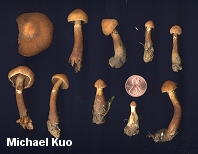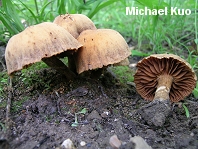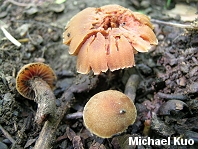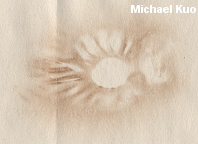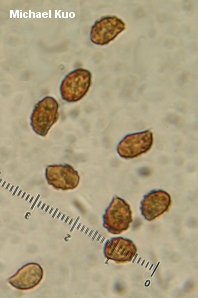| Major Groups > Gilled Mushrooms > Dark-Spored > Cortinarius > Cortinarius distans |

|
Cortinarius distans [Basidiomycetes > Agaricales > Cortinariaceae > Cortinarius ... ] by Michael Kuo This little Cortinarius is often one of the first mycorrhizal mushrooms to appear in eastern North America's hardwood forests, beginning to fruit in May or even April, depending on the weather. It is one of many boring, brownish, hard-to-identify species in the subgenus Telamonia, but its distantly spaced gills, its grainy cap surface, its whitish ring zone and its early appearance combine to help set it apart. A western variety of this species, Cortinarius distans var. olympianus, has been described (Smith, 1944) as associated with conifers in Washington; it also differs in having slightly less distant gills, a yellowish ring zone, and a stem that bruises reddish brown when handled. The European species Cortinarius hinnuleus is similar but has a fairly bald, less bell-shaped cap, and closer gills. Roger Phillips's North American treatment of "Cortinarius hinnuleus" may represent Cortinarius distans. Description: Ecology: Mycorrhizal with hardwoods, especially oaks and, in my experience, hickories; growing alone or gregariously; common in spring and early summer, but appearing through fall; widely distributed east of the Rocky Mountains (see comments below for western collections). Cap: 2-7 cm; bell-shaped to conical, becoming broadly bell-shaped or convex; moist when fresh; usually finely grainy or scaly, at least when young; orangish brown, changing color markedly as it dries out and becoming dull orangish tan; the margin at first whitish, often splitting in age. Gills: Attached to the stem, often by a notch; distant; pale brownish to nearly yellowish at first, becoming cinnamon brown; initially covered by a white cortina. Stem: 4-8 cm long; up to 1.5 cm thick; equal or club-shaped (especially when young); finely silky; brownish, with a paler apex when young; often with a white ring zone; basal mycelium whitish. Flesh: Whitish when young but soon brownish; becoming crumbly in the stem with age. Odor: Radishlike, sweetish and fragrant, or not distinctive. Chemical Reactions: KOH on cap surface slowly dark reddish brown. Spore Print: Rusty brown. Microscopic Features: Spores 6-9 x 4-6 µ; ellipsoid, often with one subfusoid end; moderately to finely ornamented; dextrinoid; orangish brown in KOH. Cheilo- and pleurocystidia absent. Pileipellis a cutis. REFERENCES: Peck, 1872. (Saccardo, 1887; Kauffman, 1918; Kauffman, 1932; Smith, 1944; Smith, Smith & Weber, 1979; Phillips, 1991/2005 [as C. hinnuleus]; Horn, Kay & Abel, 1993; Roody, 2003; Binion et al., 2008.) Herb. Kuo 06129501, 06130207, 05210403, 05260405, 05270401, 05270402, 06070803. This site contains no information about the edibility or toxicity of mushrooms. |
© MushroomExpert.Com |
|
Cite this page as: Kuo, M. (2011, November). Cortinarius distans. Retrieved from the MushroomExpert.Com Web site: http://www.mushroomexpert.com/cortinarius_distans.html |
